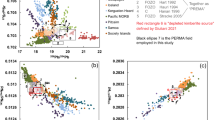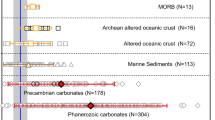Abstract
CO2 is considered to play a key role in the melting of the deep upper mantle, and carbonated silicate melts have been widely predicted by partial melting experiments to exist at mantle depths of greater than 80 km. However, such melts have not been shown to exist in nature. Thus, the relationship between CO2 and the origin of silicate melts is highly speculative. Here we present geochemical analyses of rocks sampled from the South China Sea, at the Integrated Ocean Discovery Program Site U1431. We identify natural carbonated silicate melts, which are enriched in light rare earth elements and depleted in Nb and Ta, and show that they were continuously transformed to alkali basalts that are less enriched in light rare earth elements and enriched in Nb and Ta. This shows that carbonated silicate melts can survive in the shallow mantle and penetrate through the hot asthenosphere. Carbonated silicate melts were converted to alkali basaltic melts through reactions with the lithospheric mantle, during which precipitation of apatite accounts for reduction of light rare earth elements and genesis of positive Nb–Ta anomalies. We propose that an extremely thin lithosphere (less than 20 km in the South China Sea) facilitates extrusion of the carbonated silicate melts, whereas a thickened lithosphere tends to modify carbonated silicate melt to alkali basalt.
This is a preview of subscription content, access via your institution
Access options
Access Nature and 54 other Nature Portfolio journals
Get Nature+, our best-value online-access subscription
$29.99 / 30 days
cancel any time
Subscribe to this journal
Receive 12 print issues and online access
$259.00 per year
only $21.58 per issue
Buy this article
- Purchase on Springer Link
- Instant access to full article PDF
Prices may be subject to local taxes which are calculated during checkout






Similar content being viewed by others
References
Sleep, N. H. & Zahnle, K. Carbon dioxide cycling and implications for climate on ancient Earth. J. Geophys. Res. 106, 1373–1399 (2001).
Dasgupta, R., Hirschmann, M. M. & Stalker, K. Immiscible transition from carbonate-rich to silicate-rich melts in the 3 GPa melting interval of eclogite + CO2 and genesis of silica-undersaturated ocean island lavas. J. Petrol. 47, 647–671 (2006).
Dasgupta, R., Hirschmann, M. M. & Smith, N. D. Water follows carbon: CO2 incites deep silicate melting and dehydration beneath mid-ocean ridges. Geology 35, 135–138 (2007).
Kogiso, T., Hirschmann, M. M. & Frost, D. J. High-pressure partial melting of garnet pyroxenite: possible mafic lithologies in the source of ocean island basalts. Earth Planet. Sci. Lett. 216, 603–617 (2003).
Andersen, T. & Neumann, E. R. Fluid inclusions in mantle xenoliths. Lithos 55, 301–320 (2001).
Hudgins, T. R., Mukasa, S. B., Simon, A. C., Moore, G. & Barifaijo, E. Melt inclusion evidence for CO2-rich melts beneath the western branch of the East African Rift: implications for long-term storage of volatiles in the deep lithospheric mantle. Contrib. Mineral. Petrol. 169, 1–18 (2015).
Neumann, E.-R., Wulff-Pedersen, E., Pearson, N. J. & Spencer, E. A. Mantle xenoliths from Tenerife (Canary Islands): evidence for reactions between mantle peridotites and silicic carbonatitie melts inducing Ca metasomatism. J. Petrol. 43, 825–857 (2002).
Silva, L. C., Le Bas, M. J. & Robertson, A. H. F. An oceanic carbonatite volcano on Santiago, Cape Verde Islands. Nature 294, 644–645 (1981).
Hoernle, K., Tilton, G., Le Bas, M. J. & Garbe-Schönberg, D. Geochemistry of oceanic carbonatites compared with continental carbonatites: mantle recycling of oceanic crustal carbonate. Contrib. Mineral. Petrol. 142, 520–542 (2002).
Weidendorfer, D., Schmidt, M. W. & Mattsson, H. B. Fractional crystallization of Si-undersaturated alkaline magmas leading to unmixing of carbonatites on Brava Island (Cape Verde) and a general model of carbonatite genesis in alkaline magma suites. Contrib. Mineral. Petrol. 171, 1–29 (2016).
Doucelance, R., Hammouda, T., Moreira, M. & Martins, J. C. Geochemical constraints on depth of origin of oceanic carbonatites: the Cape Verde case. Geochim. Cosmochim. Acta 74, 7261–7282 (2010).
Foley, S. F. et al. The composition of near-solidus melts of peridotite in the presence of CO2 and H2O between 40 and 60 kbar. Lithos 112S, 274–283 (2009).
Dasgupta, R., Hirschmann, M. M. & Smith, N. D. Partial melting experiments of peridotite + CO2 at 3 GPa and genesis of alkalic ocean island basalts. J. Petrol. 48, 2093–2124 (2007).
Pilet, S., Baker, M. B. & Stolper, E. M. Metasomatized lithosphere and the origin of alkaline lavas. Science 16, 916–919 (2008).
Kiseeva, E. S. et al. An experimental study of carbonated eclogite at 3.5–5.5 GPa—implications for silicate and carbonate metasomatism in the cratonic mantle. J. Petrol. 53, 727–759 (2012).
Herzberg, C. et al. Phantom Archean crust in Mangaia hotspot lavas and the meaning of heterogeneous mantle. Earth Planet. Sci. Lett. 396, 97–106 (2014).
Mallik, A. & Dasgupta, R. Reactive infiltration of MORB-eclogite-derived carbonated silicate melt into fertile peridotite at 3 GPa and genesis of alkali magmas. J. Petrol. 54, 2267–2300 (2013).
Dalou, C., Koga, K. T., Hammouda, T. & Poitrasson, F. Trace element partitioning between carbonatitic melts and mantle transition zone minerals: implications for the source of carbonatites. Geochim. Cosmochim. Acta 73, 239–255 (2009).
Sun, S. S. & McDonough, W. F. Chemical and isotopic systematics of oceanic basalts: implications for mantle composition and processes. Geol. Soc. Lond. Spec. Publ. 42, 313–345 (1989).
Willbold, M. & Stracke, A. Trace element composition of mantle end-members: implications for recycling of oceanic and upper and lower continental crust. Geochem. Geophys. Geosyst. 7, Q04004 (2006).
Kalfoun, F., Ionov, D. & Merlet, C. HFSE residence and Nb/Ta ratios in metasomatised, rutile-bearing mantle peridotites. Earth Planet. Sci. Lett. 199, 49–65 (2002).
Briais, A., Patriat, P. & Tapponnier, P. Updated interpretation of magnetic anomalies and seafloor spreading stages in the South China Sea: implications for the Tertiary tectonics of Southeast Asia. J. Geophys. Res. 98, 6299–6328 (1993).
Yan, Q. S., Shi, X. F., Wang, K. S., Bu, W. R. & Xiao, L. Major element, trace element, and Sr, Nd and Pb isotope studies of Cenozoic basalts from the South China Sea. Sci. China D 51, 550–556 (2008).
Expedition 349 Scientists. Opening of the South China Sea and its Implications for Southeast Asian Tectonics, Climates, and Deep Mantle Processes Since the Late Mesozoic International Ocean Discovery Program Expedition 349 Preliminary Report (2014); http://dx.doi.org/10.14379/iodp.pr.349.2014
Baker, M. B. & Wyllie, P. J. High-pressure apatite solubility in carbonate-rich liquids: implications for mantle metasomatism. Geochim. Cosmochim. Acta 56, 3409–3422 (1992).
Hirose, K. Partial melt compositions of carbonated peridotite at 3 GPa and role of CO2 in alkali-basalt magma generation. Geophys. Res. Lett. 24, 2837–2840 (1997).
Hammouda, T., Moine, B. N., Devidal, J. L. & Vincent, C. Trace element partitioning during partial melting of carbonated eclogites. Phys. Earth Planet. Inter. 174, 60–69 (2009).
Gerbode, C. & Dasgupta, R. Carbonate-fluxed melting of MORB-like pyroxenite at 2.9 GPa and genesis of HIMU ocean island basalts. J. Petrol. 51, 2067–2088 (2010).
Dasgupta, R., Hirschmann, M. M. & Withers, A. C. Deep global cycling of carbon constrained by the solidus of anhydrous, carbonated eclogite under upper mantle conditions. Earth Planet. Sci. Lett. 227, 73–85 (2004).
Chazot, G., Menzies, M. A. & Harte, B. Determination of partition coefficients between apatite, clinopyroxene, amphibole, and melt in natural spinel lherzolites from Yemen: implications for wet melting of the lithospheric mantle. Geochim. Cosmochim. Acta 60, 423–437 (1996).
Hammouda, T., Chantel, J. & Devidal, J.-L. Apatite solubility in carbonatitic liquids and trace element partitioning between apatite and carbonatite at high pressure. Geochim. Cosmochim. Acta 74, 7220–7235 (2010).
Hervig, R. L. & Smith, J. V. Dolomite-apatite inclusion in chrome-diopside crystal, Bellsbank kimberlite, South Africa. Am. Mineral. 66, 346–349 (1981).
Bau, M. Controls on the fractionation of isovalent trace elements in magmatic and aqueous systems: evidence from Y/Ho, Zr/Hf, and lanthanide tetrad effect. Contrib. Mineral. Petrol. 123, 323–333 (1996).
Irber, W. The lanthanide tetrad effect and its correlation with K/Rb, Eu/Eu∗, Sr/Eu, Y/Ho, and Zr/Hf of evolving peraluminous granite suites. Geochim. Cosmochim. Acta 63, 489–508 (1999).
Liu, C. Q. & Zhang, H. The lanthanide tetrad effect in apatite from the Altay No. 3 pegmatite, Xingjiang, China: an intrinsic feature of the pegmatite magma. Chem. Geol. 214, 61–77 (2005).
McDonough, W. F. & Sun, S. S. The composition of the Earth. Chem. Geol. 120, 223–253 (1995).
Arevalo, R. Jr & McDonough, W. F. Chemical variations and regional diversity observed in MORB. Chem. Geol. 271, 70–85 (2010).
Dalton, J. A. & Wood, B. J. The compositions of primary carbonate melts and their evolution through wallrock reaction in the mantle. Earth Planet. Sci. Lett. 119, 511–525 (1993).
Russell, J. K., Porritt, L. A., Lavallée, Y. & Dingwell, D. B. Kimberlite ascent by assimilation-fuelled buoyancy. Nature 481, 352–356 (2012).
Hammouda, T., Chantel, J., Manthilake, G., Guignard, J. & Crichton, W. Hot mantle geotherms stabilize calcic carbonatite magmas up to the surface. Geology 42, 911–914 (2014).
Kono, Y. et al. Ultralow viscosity of carbonate melts at high pressures. Nat. Commun. 5, 5091 (2014).
Ellam, R. M. Lithospheric thickness as a control on basalt geochemistry. Geology 20, 153–156 (1992).
Hirano, N. et al. Volcanism in response to plate flexure. Science 313, 1426–1428 (2006).
Tu, K. et al. Magmatism in the South China Basin 1. Isotopic and trace-element evidence for an endogenous Dupal mantle component. Chem. Geol. 97, 47–63 (1992).
Hart, S. R. A large-scale isotope anomaly in the Southern Hemisphere mantle. Nature 309, 753–757 (1984).
Yoshii, T., Kono, Y. & Ito, K. in Geophysics of the Pacific Ocean Basin and its Margin (eds Sutton, G. H., Manghnani, M. H. & Moberly, R.) 423–430 (Geophysical Monograph 19, 1976).
Yang, Y. H., Zhang, H. F., Chu, Z. Y., Xie, L. W. & Wu, F. Y. Combined chemical separation of Lu, Hf, Rb, Sr, Sm and Nd from a single rock digest and precise and accurate isotope determinations of Lu-Hf, Rb-Sr and Sm-Nd isotope systems using Multi-Collector ICP-MS and TIMS. Int. J. Mass Spectrom. 290, 120–126 (2010).
Kylander-Clark, A. R., Hacker, B. R. & Cottle, J. M. Laser-ablation split-stream ICP petrochronology. Chem. Geol. 345, 99–112 (2013).
Paton, C., Hellstrom, J., Paul, B., Woodhead, J. & Hergt, J. Iolite: freeware for the visualisation and processing of mass spectrometric data. J. Anal. At. Spectrom. 26, 2508–2518 (2011).
Acknowledgements
We thank the dedicated effort of the ship’s crew and scientific staff of the Drillship JOIDES Resolution. We thank X.-J. Wang for Sr–Nd–Hf isotope analyses, J.-X. Zhao and L.-F. Zhong for Pb isotope analyses, and A. Kylander-Clark for LA-ICP-MS analyses. G.-L.Z. and M.G.J. thank F. Spera for discussions on melt immiscibility. We thank C. Class for constructive suggestions. This work was financially supported by the Strategic Priority Research Program of the Chinese Academy of Sciences (XDA11030103), the National Natural Science Foundation of China (41522602, 41376065, 41372064), and AoShan Talent Program Supported by Qingdao National Laboratory for Marine Science and Technology (No. 2015ASTP).
Author information
Authors and Affiliations
Contributions
G.-L.Z. designed this project and wrote the manuscript. M.G.J., L.-H.C. and A.W.H. contributed to the scientific discussion, including interpretation of the results and scientific implications.
Corresponding authors
Ethics declarations
Competing interests
The authors declare no competing financial interests.
Supplementary information
Supplementary Information
Supplementary Information (PDF 3918 kb)
Supplementary Information
Supplementary Information (XLSX 30 kb)
Supplementary Information
Supplementary Information (XLSX 12 kb)
Rights and permissions
About this article
Cite this article
Zhang, GL., Chen, LH., Jackson, M. et al. Evolution of carbonated melt to alkali basalt in the South China Sea. Nature Geosci 10, 229–235 (2017). https://doi.org/10.1038/ngeo2877
Received:
Accepted:
Published:
Issue Date:
DOI: https://doi.org/10.1038/ngeo2877
This article is cited by
-
Deep recycling of crustal materials by the Hainan mantle plume: evidence from Zn–Sr–Nd–Pb isotopes of Hainan Island basalts
Contributions to Mineralogy and Petrology (2024)
-
Fertile upper mantle peridotite xenoliths indicate no wholesale destruction of cratonic root in East Asia
Communications Earth & Environment (2023)
-
Mantle sources of Cenozoic volcanoes around the South China Sea revealed by geochemical and isotopic data using the principal component analysis
Journal of Oceanology and Limnology (2023)
-
Melt-Lithosphere Interaction Controlled Compositional Variations in Mafic Dikes from Fujian Province, Southeastern China
Journal of Earth Science (2021)
-
Non-mantle-plume process caused the initial spreading of the South China Sea
Scientific Reports (2020)



